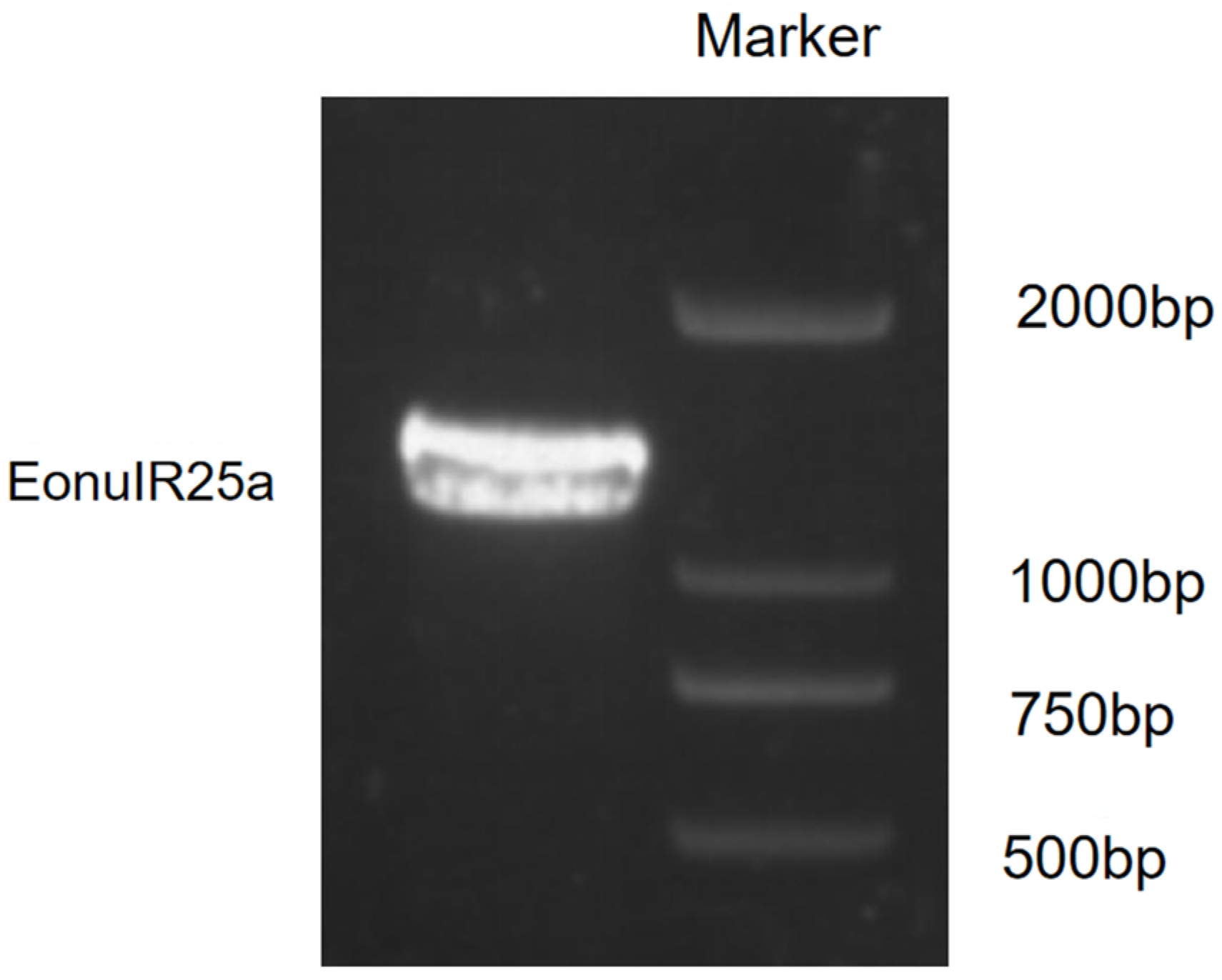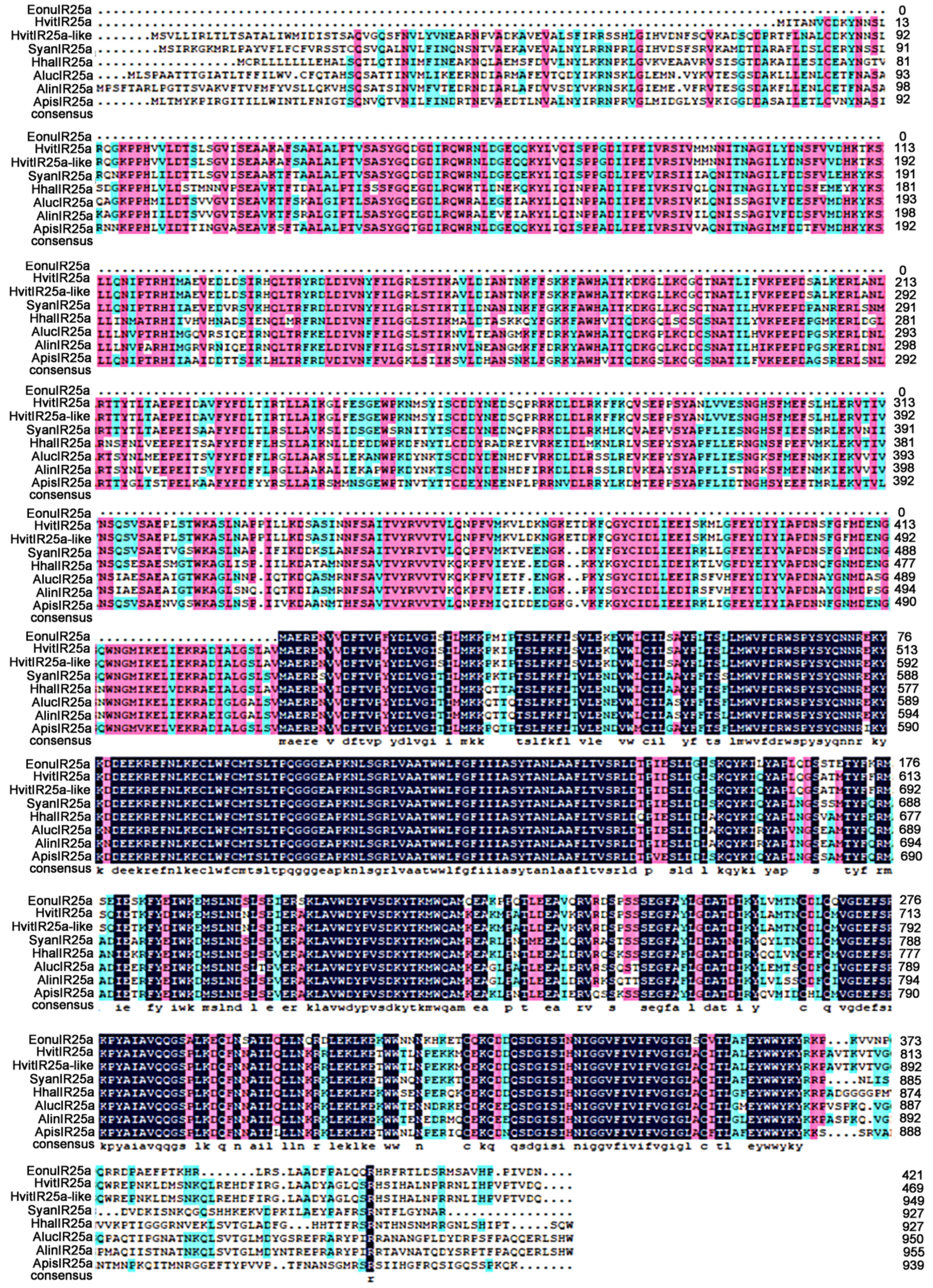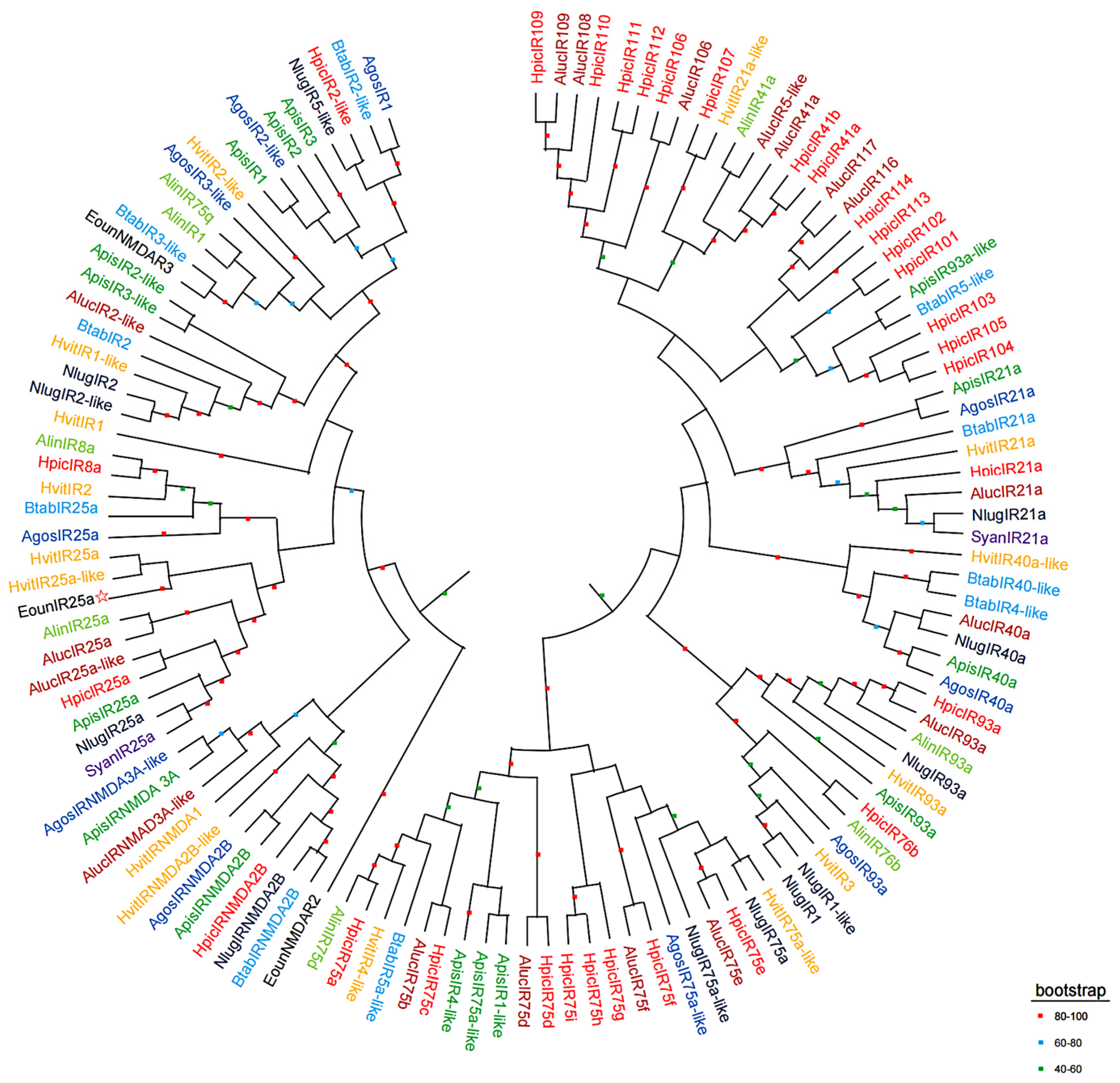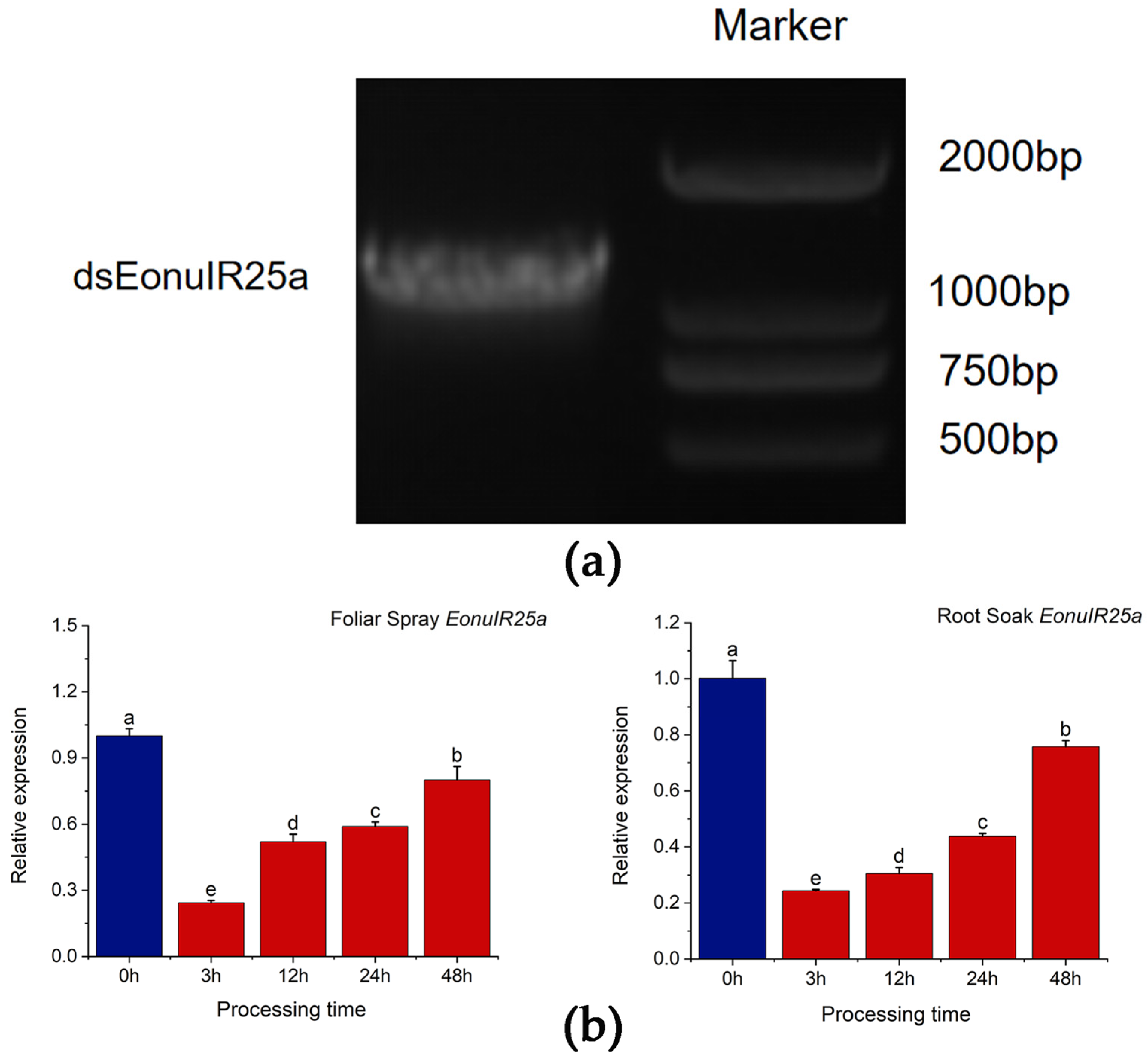Characterization of Ionotropic Receptor Gene EonuIR25a in the Tea Green Leafhopper, Empoasca onukii Matsuda
Abstract
1. Introduction
2. Results
2.1. Sequence Analysis of the EonuIR25a Gene
2.2. Multiple Sequence Alignment and Phylogenetic Tree Analysis
2.3. Tissue Expression Analysis
2.4. Correspondence of the Compounds by E. onukii
2.5. RNA Synthesis and Analysis of Interference Efficiency
2.6. Changes in the Response of E. onukii to Compounds after Silencing EonuIR25a
3. Discussion
4. Materials and Methods
4.1. Insect Culture
4.2. Total RNA Isolation and RT-PCR
4.3. Cloning and Nucleotide Sequencing
4.4. Bioinformatics Analysis
4.5. Phylogenetic Analysis
4.6. Expression in Several Tissues Using qRT-PCR
4.7. Field Experiment
4.8. Olfactometer Bioassays
4.9. DsRNA Synthesis
4.10. Feeding Method to Interfere with EonuIR25a in E. onukii
4.11. Data Statistics and Analysis
Supplementary Materials
Author Contributions
Funding
Data Availability Statement
Acknowledgments
Conflicts of Interest
References
- Gadenne, C.; Barrozo, R.B.; Anton, S. Plasticity in insect olfaction: To smell or not to Smell? Annu. Rev. Entomol. 2016, 61, 317–333. [Google Scholar] [CrossRef] [PubMed]
- Wang, Z.H.; Yang, F.; Sun, A.; Song, J.Y.; Shan, S.; Zhang, Y.J.; Wang, S.N. Expressional and functional comparisons of five clustered odorant binding proteins in the brown marmorated stink bug Halyomirpha halys. Int. J. Biol. Macromol. 2022, 209, 1352–1358. [Google Scholar] [CrossRef]
- Conchou, L.; Lucas, P.; Meslin, C.; Proffit, M.; Staudt, M.; Renou, M. Insect odorscapes: From plant volatiles to natural olfactory scenes. Front. Physiol. 2019, 10, 972. [Google Scholar] [CrossRef] [PubMed]
- Fleischer, J.; Pregitzer, P.; Breer, H.; Krieger, J. Access to the odor world: Olfactory receptors and their role for signal transduction in insects. Cell. Mol. Life Sci. 2018, 75, 485–508. [Google Scholar] [CrossRef]
- Robertson, H.M. Molecular evolution of the major arthropod chemoreceptor gene families. Annu. Rev. Entomol. 2019, 64, 227–242. [Google Scholar] [CrossRef] [PubMed]
- Leal, W. Odorant reception in insects: Roles of receptors, binding proteins, and degrading enzymes. Annu. Rev. Entomol. 2013, 58, 373–391. [Google Scholar] [CrossRef]
- Pelosi, P.; Iovinella, I.; Zhu, J.; Wang, G.R.; Dani, F.R. Beyond chemoreception: Diverse tasks of soluble olfactory proteins in insects. Biol. Rev. 2018, 93, 184–200. [Google Scholar] [CrossRef]
- Benton, R.; Vannice, K.S.; Gomez-Diaz, C.; Vosshall, L.B. Variant ionotropic glutamate receptors as chemosensory receptors in Drosophila. Cell 2009, 136, 149–162. [Google Scholar] [CrossRef]
- Mayer, M.L.; Armstrong, N. Structure and function of glutamate receptor ion channels. Annu. Rev. Physiol. 2004, 66, 161–181. [Google Scholar] [CrossRef]
- Armstrong, N.; Sun, Y.; Chen, G.Q.; Gouaux, E. Structure of a glutamate-receptor ligand-binding core in complex with kainate. Nature 1998, 395, 913–917. [Google Scholar] [CrossRef]
- Kuner, T.; Seeburg, P.H.; Guy, H.R. A common architecture for K+ channels and ionotropic glutamate receptors? Trends Neurosci. 2003, 26, 27–32. [Google Scholar] [CrossRef]
- Croset, V.; Rytz, R.; Cummins, S.F.; Budd, A.; Brawand, D.; Kaessmann, H.; Gibson, T.J.; Benton, R. Ancient protostome origin of chemosensory ionotropic glutamate receptors and the evolution of insect taste and olfaction. PLoS Genet. 2010, 6, e1001064. [Google Scholar] [CrossRef] [PubMed]
- Chen, C.H.; Buhl, E.; Xu, M.; Croset, V.; Rees, J.S.; Lilley, K.S.; Benton, R.; Hodge, J.J.L.; Stanewsky, R. Drosophila Ionotropic Receptor 25a mediates circadian clock resetting by temperature. Nature 2015, 527, 516–520. [Google Scholar] [CrossRef]
- Lee, Y.; Poudel, S.; Kim, Y.; Thakur, D.; Montell, C. Calcium taste avoidance in Drosophila. Neuron 2018, 97, 67–74. [Google Scholar] [CrossRef] [PubMed]
- Steck, K.; Walker, S.J.; Itskov, P.M.; Baltazar, C.; Moreira, J.M.; Ribeiro, C. Internal amino acid state modulates yeast taste neurons to support protein homeostasis in Drosophila. Elife 2018, 7, e31625. [Google Scholar] [CrossRef]
- Sánchez-Alcañiz, J.A.; Silbering, A.F.; Croset, V.; Zappia, G.; Sivasubramaniam, A.K.; Abuin, L.; Sahai, S.Y.; Münch, D.; Steck, K.; Auer, T.O.; et al. An expression atlas of variant ionotropic glutamate receptors identifies a molecular basis of carbonation sensing. Nat. Commun. 2018, 9, 4252. [Google Scholar] [CrossRef]
- Wang, S.N.; Peng, Y.; Lu, Z.Y.; Dhiloo, K.H.; Zheng, Y.; Shan, S.; Li, R.J.; Zhang, Y.J.; Guo, Y.Y. Cloning and expression profile of ionotropic receptors in the parasitoid wasp Microplitis mediator (Hymenoptera: Braconidae). J. Insect Physiol. 2016, 90, 27–35. [Google Scholar] [CrossRef]
- Rimal, S.; Lee, Y. The multidimensional ionotropic receptors of Drosophila melanogaster. Insect Mol. Biol. 2018, 27, 1–7. [Google Scholar] [CrossRef]
- Task, D.; Lin, C.C.; Vulpe, A.; Afify, A.; Ballou, S.; Brbi, M.; Schlegel, P.; Jefferis, G.S.X.E.; Li, H.; Menuz, K. Chemoreceptor co-expression in Drosophila melanogaster olfactory neurons. Elife. 2022, 11, e72599. [Google Scholar] [CrossRef] [PubMed]
- Wang, Q.; Xu, P.; Sanchez, S.; Duran, P.; Andreazza, F.; Isaacs, R.; Dong, K. Behavioral and physiological responses of Drosophila melanogaster and D. suzukii to volatiles from plant essential oils. Pest Manag. Sci. 2021, 77, 3698–3705. [Google Scholar] [CrossRef]
- Knecht, Z.A.; Silbering, A.F.; Ni, L.; Klein, M.; Budelli, G.; Abuin, L.; Ferrer, A.J.; Samuel, A.D.T. Distinct combinations of variant ionotropic glutamate receptors mediate thermosensation and hygrosensation in Drosophila. Elife 2016, 5, e17879. [Google Scholar] [CrossRef] [PubMed]
- Raji, J.I.; Melo, N.; Castillo, J.S.; Gonzalez, S.; Saldana, V.; Stensmyr, M.C.; DeGennaro, M. Aedes aegypti mosquitoes detect acidic volatiles found in human odor using the IR8a pathway. Curr. Biol. 2019, 29, 1253–1262. [Google Scholar] [CrossRef] [PubMed]
- Liu, C.; Pitts, R.J.; Bohbot, J.D.; Jones, P.L.; Wang, G.; Zwiebel, L.J. Distinct olfactory signaling mechanisms in the malaria vector mosquito Anopheles gambiae. PLoS Biol. 2010, 8, 27–28. [Google Scholar] [CrossRef]
- Tang, R.; Jiang, N.J.; Ning, C.; Li, C.; Huang, L.Q.; Wang, C.Z. The olfactory reception of acetic acid and ionotropic receptors in the Oriental armyworm, Mythimna separata Walker. Insect Biochem. Mol. Biol. 2020, 118, 103312. [Google Scholar] [CrossRef] [PubMed]
- Zhang, J.; Bisch-Knaden, S.; Fandino, R.A.; Yan, S.; Obiero, G.F.; Grosse-Wilde, E.; Hansson, B.S.; Knaden, M. The olfactory coreceptor IR8a coverns larval fecesmediated competition avoidance in a hawkmoth. Proc. Natl. Acad. Sci. USA 2019, 116, 21828–21833. [Google Scholar] [CrossRef]
- Pitts, R.J.; Derryberry, S.L.; Zhang, Z.W.; Zwiebel, L.J. Variant ionotropic receptors in the malaria vector mosquito Anopheles gambiae tuned to amines and carboxvlic acids. Sci. Rep. 2017, 7, 40297. [Google Scholar] [CrossRef]
- Ahn, J.E.; Chen, Y.; Amrein, H. Molecular basis of fatty acid taste in Drosophila. Elife 2017, 6, e30115. [Google Scholar] [CrossRef]
- Frank, D.D.; Enjin, A.; Jouandet, G.C.; Zaharieva, E.E.; Para, A.; Stensmyr, M.C.; Gallio, M. Early integration of temperature and humidity stimuli in the Drosophila brain. Curr. Biol. 2017, 27, 2381–2388. [Google Scholar] [CrossRef]
- Budelli, G.; Ni, L.; Berciu, C.; van Giesen, L.; Knecht, Z.A.; Chang, E.C.; Kaminski, B.; Silbering, A.F.; Samuel, A.; Klein, M.; et al. Ionotropic receptors specify the morphogenesis of phasic sensors controlling rapid thermal preference in Drosophila. Neuron 2019, 101, 738–747. [Google Scholar] [CrossRef]
- da Silva Pinto, M. Tea: A new perspective on health benefits. Food Res. Int. 2013, 53, 558–567. [Google Scholar] [CrossRef]
- Ye, G.Y.; Xiao, Q.; Chen, M.; Chen, X.X.; Yuan, Z.Y.; Stanley, D.W.; Hu, C. Tea: Biological control of insect and mite pests in China. Biol. Control 2014, 68, 73–91. [Google Scholar] [CrossRef]
- Xin, Z.J.; Li, X.W.; Bian, L.; Sun, X.L. Tea green leafhopper, Empoasca vitis, chooses suitable host plants by detecting the emission level of (3Z)-hexenyl acetate. B Entomol. Res. 2017, 107, 77–84. [Google Scholar] [CrossRef]
- Silva, L. A brief history of biochemical genetics’ 50 years and a reflection about past and present research directions. Biochem. Genet. 2018, 56, 1–6. [Google Scholar] [CrossRef] [PubMed]
- Bian, L.; Cai, X.M.; Luo, Z.X.; Li, Z.Q.; Xin, Z.J.; Chen, Z.M. Design of an attractant for Empoasca onukii (Hemiptera: Cicadellidae) based on the volatile components of fresh tea leaves. J. Econ. Entomol. 2018, 111, 629–636. [Google Scholar] [CrossRef] [PubMed]
- Zhang, L.; Zhao, M.; Aikeremu, F.; Huang, H.; You, M.; Zhao, Q. Involvement of three chemosensory proteins in perception of host plant volatiles in the tea green leafhopper, Empoasca onukii. Frontiers 2023, 13, 2687. [Google Scholar] [CrossRef]
- Bian, L.; Li, Z.Q.; Ma, L.; Cai, X.M.; Luo, Z.X.; Chen, Z.M. Identification of the genes in tea leafhopper, Empoasca onukii (Hemiptera: Cicadellidae), that encode odorant-binding proteins and chemosensory proteins using transcriptome analyses of insect heads. Appl. Entomol. Zool. 2018, 53, 93–105. [Google Scholar] [CrossRef]
- Zhao, Y.; Li, H.; Wang, Q.; Liu, J.; Zhang, L.; Mu, W.; Xu, Y.; Zhang, Z.; Gu, S. Identification and expression analysis of chemosensory genes in the tea green leafhopper, Empoasca onukii Matsuda. J. Appl. Entomol. 2018, 142, 828–846. [Google Scholar] [CrossRef]
- Ni, L. The structure and function of ionotropic receptors in Drosophila. Front. Mol. Neurosci. 2021, 13, 638839. [Google Scholar] [CrossRef] [PubMed]
- Rytz, R.; Croset, V.; Benton, R. Ionotropic receptors (IRs): Chemosensory ionotropic glutamate receptors in Drosophila and beyond. Insect Biochem. Mol. 2013, 43, 888–897. [Google Scholar] [CrossRef]
- Wang, T.T.; Hao, Y.J.; He, Z.B.; Met, T.; Chen, B. Characteristics and classification position of the ionotropic receptor genes IR8a and IR25a in four vector mosquito species of medical importance. Acta Entomol. Sin. 2017, 60, 379–388. [Google Scholar] [CrossRef]
- Guo, M.; Krieger, J.; Grosse-Wilde, E.; Missbach, C.; Zhang, L.; Breer, H. Variant ionotropic receptors are expressed in olfactory sensory neurons of coeloconic sensilla on the antenna of the desert locust (Schistocerca gregaria). Int. J. Biol. Sci. 2014, 10, 1–14. [Google Scholar] [CrossRef] [PubMed]
- Ganguly, A.; Pang, L.; Duong, V.K.; Lee, A.; Schoniger, H.; Varady, E.; Dahanukar, A. A molecular and cellular context-dependent role for Ir76b in detection of amino acid taste. Cell Rep. 2017, 18, 737–750. [Google Scholar] [CrossRef] [PubMed]
- Ai, M.; Min, S.; Grosjean, Y.; Leblanc, C.; Bell, R.; Benton, R.; Suh, G.S.B. Acid sensing by the Drosophila olfactory system. Nature 2010, 468, 691–695. [Google Scholar] [CrossRef] [PubMed]
- Min, S.; Ai, M.; Shin, S.A.; Suh, G.S. Dedicated olfactory neurons mediating attraction behavior to ammonia and amines in Drosophila. Proc. Natl. Acad. Sci. USA 2013, 110, E1321–E1329. [Google Scholar] [CrossRef]
- Hussain, A.; Zhang, M.; Ucpunar, H.K.; Syensson, T.; Quillery, E.; Gompel, N.; Ignell, R.; Grunwald Kadow, I.C. Ionotropic chemosensory receptors mediate the taste and smell of polyamines. PLoS Biol. 2016, 14, e1002454. [Google Scholar] [CrossRef] [PubMed]
- Chen, Y.; Amrein, H. Ionotropic receptors mediate Drosophila oviposition preference through sour gustatory receptor neurons. Curr. Biol. 2017, 27, 2741–2750. [Google Scholar] [CrossRef]
- Ai, M.; Blais, S.; Park, J.Y.; Min, S.; Neubert, T.A.; Suh, G.S. Ionotropic glutamate receptors IR64a and IR8a form a functional odorant receptor complex in vivo in Drosophila. J. Neurosci. 2013, 33, 10741–10749. [Google Scholar] [CrossRef]
- Gregg, P.C.; Del Socorro, A.P.; Hawes, A.J.; Binns, M.R. Developing bisexual attract-and-kill for polyphagous insects: Ecological rationale versus pragmatics. J. Chem. Ecol. 2016, 42, 666–675. [Google Scholar] [CrossRef] [PubMed]
- Di, C.; Ning, C.; Huang, L.Q.; Wang, C.Z. Design of larval chemical atractants based on odorant response spectra of odorantreceptors in the cotton bollworm. Insect Biochem. Mol. Biol. 2017, 84, 48–62. [Google Scholar] [CrossRef]
- Shepherd, W.P.; Sullivan, B.T. Southern pine beetle, Dendroctonus frontalis, antennal and behavioral responses to nonhost leaf and bark volatiles. J. Chem. Ecol. 2013, 39, 481–493. [Google Scholar] [CrossRef]
- Wang, C.; Li, G.N.; Miao, C.J.; Zhao, M.; Wang, B.; Guo, X.R. Nonanal modulates oviposition preference in female Helicoverpa assulta (Lepidoptera: Noctuidae) via the activation of peripheral neurons. Pest Manag. Sci. 2020, 76, 3159–3167. [Google Scholar] [CrossRef]
- Magsi, F.H.; Luo, Z.X.; Zhao, Y.J.; Li, Z.Q.; Cai, X.M.; Bian, L.; Chen, Z.M. Electrophysiological and behavioral responses of Dasychira baibarana (Lepidoptera: Lymantriidae) to tea plant volatiles. Environ. Entomol. 2021, 50, 589–598. [Google Scholar] [CrossRef] [PubMed]
- Hou, X.Q.; Zhang, D.D.; Powell, D.; Wang, H.L.; Andersson, M.N.; Löfstedt, C. Ionotropic receptors in the turnip moth Agrotis segetum respond to repellent medium-chain fatty acids. BMC Biol. 2022, 20, 1–19. [Google Scholar] [CrossRef]
- Schutter, K.D.; Taning, C.N.T.; Daele, L.V.; Van Damme, E.J.M.; Dubruel, P.; Smagghe, G. RNAi-based biocontrol products: Market status, regulatory aspects, and risk assessment. Front. Insect Sci. 2022, 1, 818037. [Google Scholar] [CrossRef]
- Christiaens, O.; Whyard, S.; Vélez, A.M.; Smagghe, G. Double-stranded RNA technology to control insect pests: Current status and challenges. Front. Plant Sci. 2020, 11, 451. [Google Scholar] [CrossRef] [PubMed]
- Souza, D.; Christensen, S.A.; Wu, K.; Buss, L.; Kleckner, K.; Darrisaw, C.; Shirk, P.D.; Siegfried, B.D. RNAi-induced knockdown of white gene in the southern green stink bug (Nezara viridula L.). Sci. Rep. 2022, 12, 10396. [Google Scholar] [CrossRef] [PubMed]
- Joga, M.R.; Zotti, M.; Smagghe, G.; Christiaens, O. RNAi efficiency, systemic properties, and novel delivery methods for pest insect control: What we know so far. Front. Physiol. 2016, 7, 553. [Google Scholar] [CrossRef]
- Kunte, N.; Mcgraw, E.; Bell, S.; Held, D.; Avila, L. Prospects, challenges and current status of RNAi through insect feeding. Pest Manag. Sci. 2020, 76, 26–41. [Google Scholar] [CrossRef]
- Andrade, E.C.; Hunter, W.B. RNAi feeding bioassay: Development of a non-transgenic approach to control Asian citrus psyllid and other hemipterans. Entomol. Exp. Appl. 2017, 162, 389–396. [Google Scholar] [CrossRef]
- Yan, S.; Qian, J.; Cai, C.; Ma, Z.Z.; Li, J.H.; Yin, M.Z.; Ren, B.; Shen, J. Spray method application of transdermal dsRNA delivery system for efficient gene silencing and pest control on soybean aphid Aphis glycines. J. Pest Sci. 2020, 93, 449–459. [Google Scholar] [CrossRef]
- Li, H.; Bowling, A.J.; Gandra, P.; Rangasamy, M.; Pence, H.E.; McEwan, R.E.; Khajuria, C.; Siegfried, B.D.; Narva, K.E. Narva Systemic RNAi in western corn rootworm, Diabrotica virgifera virgifera, does not involve transitive pathways. Insect Sci. 2018, 25, 45–56. [Google Scholar] [CrossRef]
- Khajuria, C.; Velez, A.M.; Rangasamy, M.; Wang, H.C.; Fishilevich, E.; Frey, M.L. Parental RNA interference of genes involved in embryonic development of the western corn rootworm, Diabrotica virgifera virgifera LeConte. Insect Biochem. Mol. Biol. 2015, 63, 54–62. [Google Scholar] [CrossRef] [PubMed]
- Ramaseshadri, P.; Segers, G.; Flannagan, R.; Wiggins, E.; Clinton, W.; Ilagan, O.; McNulty, B.; Clark, T.; Bolognesi, R. Physiological and cellular responses caused by RNAi-mediated suppression of Snf7 orthologue in western corn rootworm (Diabrotica virgifera virgifera) larvae. PLoS ONE 2013, 8, e54270. [Google Scholar] [CrossRef] [PubMed]
- Zhu, K.Y.; Palli, S.R. Mechanisms, applications, and challenges of insect RNA interference. Annu. Rev. Entomol. 2020, 65, 293–311. [Google Scholar] [CrossRef]
- Arpaia, S.; Christiaens, O.; Giddings, K.; Jones, H.; Dietz-Pfeilstetter, A. Biosafety of GM crop plants expressing dsRNA: Data requirements and EU regulatory considerations. Front. Plant. Sci. 2020, 11, 940. [Google Scholar] [CrossRef] [PubMed]
- Darlington, M.; Reinders, J.D.; Sethi, A.; Lu, A.L.; Ramaseshadri, P.; Fischer, J.R.; Boeckman, C.J.; Petrick, J.S.; Roper, J.M.; Narva, K.E.; et al. RNAi for Western corn rootworm management: Lessons learned, challenges, and future directions. Insects 2022, 13, 57. [Google Scholar] [CrossRef] [PubMed]
- Rank, A.P.; Koch, A. Lab-to-field transition of RNA spray applications-How far are we? Front. Plant Sci. 2021, 12, 755203. [Google Scholar] [CrossRef]
- Christiaens, O.; Dzhambazova, T.; Kostov, K.; Arpaia, S.; Joga, M.R.; Urru, I.; Sweet, J.; Smagghe, G. Literature review of baseline information on RNAi to support the environmental risk assessment of RNAi-based GM plants. EFSA Support. Publ. 2018, 15, 1424E. [Google Scholar] [CrossRef]
- Mendelsohn, M.L.; Gathmann, A.; Kardassi, D.; Sachana, M.; Székács, A. Summary of Discussions From the 2019 OECD Conference on RNAi Based Pesticides. Front. Plant. Sci. 2020, 11, 740. [Google Scholar] [CrossRef] [PubMed]
- Cui, Y.Y.; Wang, J.G.; Liu, Q.Y.; Li, D.M.; Zhang, W.; Liu, X.B.; Wang, J.; Song, X.P.; ·Yao, F.; Wu, H.X.; et al. Identification and expression of potential olfactory-related genes related to Niemann–Pick C2 protein and ionotropic receptors in Haemaphysalis longicornis. Exp. Appl. Acarol. 2022, 87, 337–350. [Google Scholar] [CrossRef]
- Zhang, Y.; Yang, B.Y.; Yu, J.; Pang, B.P.; Wang, G.R. Expression profiles and functional prediction of ionotropic receptors in Asian corn borer, Ostrinia furnacalis (Lepidoptera: Crambidae). J. Integr. Agric. 2022, 21, 474–485. [Google Scholar] [CrossRef]
- Wicher, D.; Miazzi, F. Functional properties of insect olfactory receptors: Ionotropic receptors and odorant receptors. Cell Tissue Res. 2021, 383, 7–19. [Google Scholar] [CrossRef] [PubMed]
- Yin, N.N.; Nuo, S.M.; Xiao, H.Y.; Zhao, Y.J.; Zhu, J.Y.; Liu, N.Y. The ionotropic receptor gene family in Lepidoptera and Trichoptera: Annotation, evolutionary and functional perspectives. Genomics 2021, 113, 601–612. [Google Scholar] [CrossRef] [PubMed]
- Tamura, K.; Peterson, D.; Peterson, N.; Stecher, G.; Nei, M.; Kumar, S. MEGA5: Molecular evolutionary genetics analysis using maximum likelihood, evolutionary distance, and maximum parsimony methods. Mol. Biol. Evol. 2011, 28, 2731–2739. [Google Scholar] [CrossRef]
- Livak, K.J.; Schmittgen, T.D. Analysis of relative gene expression data using real-time quantitative PCR and the 2−ΔΔCT method. Methods 2001, 25, 402–408. [Google Scholar] [CrossRef]








| Gene | Forward Primer (5′–3′) | Reverse Primer (5′–3′) | PCR Type |
|---|---|---|---|
| EonuIR25a | GGGGTACCATGGCAGAGAGAGAGAATGTC | CCGCTCGAGTTAATTATCAACGATAGGCGGATG | RT–PCR |
| EonuIR25a | TCTTCAAGTTCCTCAGCGTTC | CATCTTTGTACTTCTCCCGATT | qRT–PCR |
| dsEonuIR25a | TAATACGACTCACTATAGGGATGGCAGAGAGAGAGAATGTC | TAATACGACTCACTATAGGGTTAATTATCAACGATAGGCGGATG | RT–PCR |
| β-actin | AGCGTGGTTACTCTTTCA | GCAACTCGTAGGACTTCT | qRT–PCR |
Disclaimer/Publisher’s Note: The statements, opinions and data contained in all publications are solely those of the individual author(s) and contributor(s) and not of MDPI and/or the editor(s). MDPI and/or the editor(s) disclaim responsibility for any injury to people or property resulting from any ideas, methods, instructions or products referred to in the content. |
© 2023 by the authors. Licensee MDPI, Basel, Switzerland. This article is an open access article distributed under the terms and conditions of the Creative Commons Attribution (CC BY) license (https://creativecommons.org/licenses/by/4.0/).
Share and Cite
Zhang, R.; Lun, X.; Zhang, Y.; Zhao, Y.; Xu, X.; Zhang, Z. Characterization of Ionotropic Receptor Gene EonuIR25a in the Tea Green Leafhopper, Empoasca onukii Matsuda. Plants 2023, 12, 2034. https://doi.org/10.3390/plants12102034
Zhang R, Lun X, Zhang Y, Zhao Y, Xu X, Zhang Z. Characterization of Ionotropic Receptor Gene EonuIR25a in the Tea Green Leafhopper, Empoasca onukii Matsuda. Plants. 2023; 12(10):2034. https://doi.org/10.3390/plants12102034
Chicago/Turabian StyleZhang, Ruirui, Xiaoyue Lun, Yu Zhang, Yunhe Zhao, Xiuxiu Xu, and Zhengqun Zhang. 2023. "Characterization of Ionotropic Receptor Gene EonuIR25a in the Tea Green Leafhopper, Empoasca onukii Matsuda" Plants 12, no. 10: 2034. https://doi.org/10.3390/plants12102034
APA StyleZhang, R., Lun, X., Zhang, Y., Zhao, Y., Xu, X., & Zhang, Z. (2023). Characterization of Ionotropic Receptor Gene EonuIR25a in the Tea Green Leafhopper, Empoasca onukii Matsuda. Plants, 12(10), 2034. https://doi.org/10.3390/plants12102034







